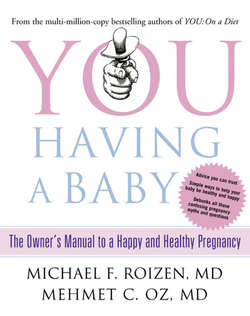Читать книгу You: Having a Baby: The Owner’s Manual to a Happy and Healthy Pregnancy - Michael Roizen F. - Страница 60
Metabolic Magic: How Your Nutrition Influences His
ОглавлениеFactoid: How often does your baby move? Unless you’ve got a counter, it’s hard to keep up. At twenty weeks, the average is about 200 times a day. At thirty-two weeks, it’s 575. At forty weeks, that number drops to about 300. The reason? There’s less room for the tyke to move around as it grows.
Remember from our introduction about how pregnancy is a lot like a ballroom dance, with you and your partner nudging each other in different directions? Nowhere does this dance play out more than when it comes to metabolism. As your hormones surge during pregnancy, your body changes too. It changes the way it processes energy, it changes the way you store fat, and ultimately it changes the way you deliver nutrients to your baby.
Considering the torture you’ve already put your body through at various times in your life,* you’re already pretty aware of how amazingly responsive human metabolic processes can be. For example, our bodies are able to weather all kinds of biological storms, adapting to such things as high altitudes and extreme climates. Your metabolism also makes adjustments when it sees another kind of biological storm: pregnancy.
In a nonpregnant person, metabolism typically works this way (see figure 4.1). When you eat food, your body converts it to energy in the form of the sugar called glucose. That glucose goes through the liver, where it’s processed into fat, proteins, and carbohydrates, and gets shuttled around your body to help your muscles and tissues function.
Figure 4.1 Energy Efficient When you eat, your body takes the calories and converts them to glucose, your body’s energy source. With insulin serving as glucose’s carrier pigeon, that glucose is shuttled throughout the body to help all of your muscles and organs function smoothly. In pregnancy, that system often is much more resistant, as your body needs to make sure to provide the glucose to your baby.
Glucose, like underage airplane passengers, can’t travel alone. It needs some assistance: specifically, something to help it get from the bloodstream into the cells to provide the energy you need to breathe, to make your heart beat, and even to do the missionary mambo that got you into this condition in the first place.
The pancreas provides the hormone insulin, which chaperones glucose throughout the body and facilitates its entry into the cells. It’s a nice, efficient system that allows the food you eat to provide the energy that all parts of your body need to function. In a perfect world, there’s the right amount of glucose, the right amount of insulin, and life is simply swell.
Now, consider what happens when the metabolic storm comes rolling in, in the form of—bada-bing—little Leonard. Lenny’s not quite ready for smashed turnips when he’s doing laps in amniotic fluid, so he needs some of mom’s chemical nectar to keep him growing in utero. And yep, that energy-giving and baby-growing nectar comes in the form of—you got it—glucose.
Because the baby’s brain depends on glucose, the placenta’s mission is to make sure that the glucose cupboard is never, ever bare. In fact, if the fetus’s blood sugar drops below the magic number—90 milligrams per deciliter of blood (mg/dl)—for even a few minutes, the fetus can suffer irreversible brain damage. So the placenta produces a hormone called human placental lactogen (hPL), which inhibits mom’s insulin from getting glucose into her cells, thereby increasing mom’s bloodstream glucose levels available to baby. Big-time. The hormone hPL is almost identical in structure to the growth hormone present in all women. But in pregnant women, it can reach a thousand times the equivalent normal concentration. And you can see why: no glucose for baby, no development; no development, no birth. Human placental lactogen acts like maternal growth hormone, helping all the mother’s structures grow appropriately as well.
When hPL blocks insulin’s ability to transport glucose into your cells, it allows your baby to get the glucose he needs to grow. This hormonal dance, delicate and subtle as it is, ultimately influences whether your baby will achieve a target weight during pregnancy or not. And when this dance gets a little bit out of sync—oftentimes through absolutely no fault of the mom—that’s when we start to see issues that can influence both the development of your baby as he grows inside you and your baby’s future health after birth.
